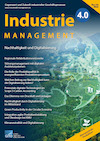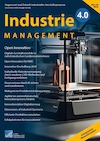Search


Bibtex
Cite as text
@Article{Harbich+Schnelle+Kersten,
Cite-key = "Harbich2023Potenziale",
Year= "2023",
Number= "2",
Volume= "IM 39",
Pages= "29-32",
Journal = "Industrie 4.0 Management",
Title= "Potenziale digitaler Technologien im Scope 3-Carbon Accounting ",
Author= "Hannah-Deborah Harbich, Johannes Schnelle und Wolfgang Kersten, Technische Universität Hamburg",
Doi= "https://doi.org/10.30844/IM_23-2_29-32",
Abstract= "Der Klimawandel stellt eine der größten Herausforderungen für Unternehmen dar. Um Strategien für die Dekarbonisierung der eigenen Geschäftstätigkeiten festlegen zu können, ist die Berechnung von Treibhausgasemissionen notwendig. Insbesondere die Erfassung von Daten entlang der vor- und nachgelagerten Wertschöpfungskette (Scope 3) ist gegenwärtig ein komplexer, ressourcenintensiver und häufig ungenauer Prozess. Entsprechend wächst der Bedarf nach innovativen Lösungen, um das Scope 3-Carbon Accounting zu verbessern. Dieser Beitrag zeigt auf, wie digitale Technologien das Scope 3-Carbon Accounting unterstützen können.",
Keywords= "Scope 3, Carbon Accounting, Digitalisierung, Technologien",
}
Hannah-Deborah Harbich, Johannes Schnelle und Wolfgang Kersten, Technische Universität Hamburg(2023): Potenziale digitaler Technologien im Scope 3-Carbon Accounting . IM 392(2023), S. 29-32. Online: https://doi.org/10.30844/IM_23-2_29-32 (Abgerufen 26.07.24)
Open Access
Abstract
Abstract
Der Klimawandel stellt eine der größten Herausforderungen für Unternehmen dar. Um Strategien für die Dekarbonisierung der eigenen Geschäftstätigkeiten festlegen zu können, ist die Berechnung von Treibhausgasemissionen notwendig. Insbesondere die Erfassung von Daten entlang der vor- und nachgelagerten Wertschöpfungskette (Scope 3) ist gegenwärtig ein komplexer, ressourcenintensiver und häufig ungenauer Prozess. Entsprechend wächst der Bedarf nach innovativen Lösungen, um das Scope 3-Carbon Accounting zu verbessern. Dieser Beitrag zeigt auf, wie digitale Technologien das Scope 3-Carbon Accounting unterstützen können.
Keywords
Schlüsselwörter
Scope 3, Carbon Accounting, Digitalisierung, Technologien
References
Referenzen
Literatur
[1] Talbot, D.; Boiral, O.: GHG Reporting and Impression Management: An Assessment of Sustainability Reports from the Energy Sector. In: Journal of Business Ethics 147 (2018) 2, S. 367-83.
[2] Csutora, M.; Harangozo, G.: Twenty years of carbon accounting and auditing – a review and outlook. In: Society and Economy 39 (2017) 4, S. 459-80.
[3] Huang, Y. A.; Weber, C. L.; Matthews, H. S.: Categorization of Scope 3 emissions for streamlined enterprise carbon footprinting. In: Environmental science & technology 43 (2009) 22, S. 8509-15.
[4] WRI; WBCSD: Corporate Value Chain (Scope 3) Accounting and Reporting Standard.
URL: https://ghgprotocol.org/sites/default/files/standards/Corporate-Value-Chain-Accounting-Reporing-Standard_041613_2.pdf, Abrufdatum 09.11.2022.
[5] Harbich, H.-D.; See, B. von; Lodemann, S.; Kuhnle, R.; Kersten, W.: Digital Scope 3 Carbon Accounting. Vision, Challenges, and Future Direction.
In: Biedermann, H.; Posch, W.; Vorbach, S. (Hrsg): Digitalisierung im Kontext von Nachhaltigkeit und Klimawandel. 2021.
[6] WBCSD: Pathfinder Framework. Guidance for the Accounting and Exchange of Product Life Cycle Emissions.
URL: https://www.wbcsd.org/contentwbc/download/13299/194600/1, Abrufdatum 06.11.2022.
[7] Harangozo, G.; Szigeti, C.: Corporate carbon footprint analysis in practice – With a special focus on validity and reliability issues. In: Journal of Cleaner Production 167 (2017), S. 1177-83.
[8] Patchell, J.: Can the implications of the GHG Protocol’s Scope 3 standard be realized? In: Journal of Cleaner Production 185 (2018), S. 941-58.
[9] Asif, M. S.; Lau, H.; Nakandala, D.; Fan, Y.; Hurriyet, H.: Case study research of green life cycle model for the evaluation and reduction of Scope 3 emissions in food supply chains. In: Corporate Social Responsibility and Environmental Management 29 (2022) 4, S. 1050-66.
[10] Marston, S.; Li, Z.; Bandyopadhyay, S.; Zhang, J.; Ghalsasi, A.: Cloud computing — The business perspective. In: Decision Support Systems 51 (2011) 1, S. 176-89.
[11] Xing, K.; Qian, W.; Zaman, A. U.: Development of a cloud-based platform for footprint assessment in green supply chain management. In: Journal of Cleaner Production 139 (2016), S. 191-203.
[12] Royo, B.: Measuring and Allocating Scope 3 GHG Emissions. In: Müller, B.; Meyer, G. (Hrsg): Towards User-Centric Transport in Europe 2. Enablers of Inclusive, Seamless and Sustainable Mobility. Cham 2020.
[13] Rusch, M.; Schöggl, J.-P.; Baumgartner, R. J.: Application of digital technologies for sustainable product management in a circular economy: A review. In: Business Strategy and the Environment (2022).
[14] Cole, R.; Stevenson, M.; Aitken, J.: Blockchain technology: implications for operations and supply chain management. In: Supply Chain Management: An International Journal 24 (2019) 4, S. 469-83.
[15] Tang, Q.; Tang, L. M.: Toward a Distributed Carbon Ledger for Carbon Emissions Trading and Accounting for Corporate Carbon Management. In: Journal of Emerging Technologies in Accounting 16 (2019) 1, S. 37-46.
[16] Garrido-Hidalgo, C.; Olivares, T.; Ramirez, F. J.; Roda-Sanchez, L.: An end-to-end Internet of Things solution for Reverse Supply Chain Management in Industry 4.0. In: Computers in Industry 112 (2019), S. 103127.
[17] Martindale, W.: Connecting food supply chains. In: Food Science and Technology 36 (2022) 3, S. 28-32.
[18] Serafeim, G.; Velez Caicedo, G.: Machine Learning Models for Prediction of Scope 3 Carbon Emissions. In: SSRN Electronic Journal (2022).

 English
English
